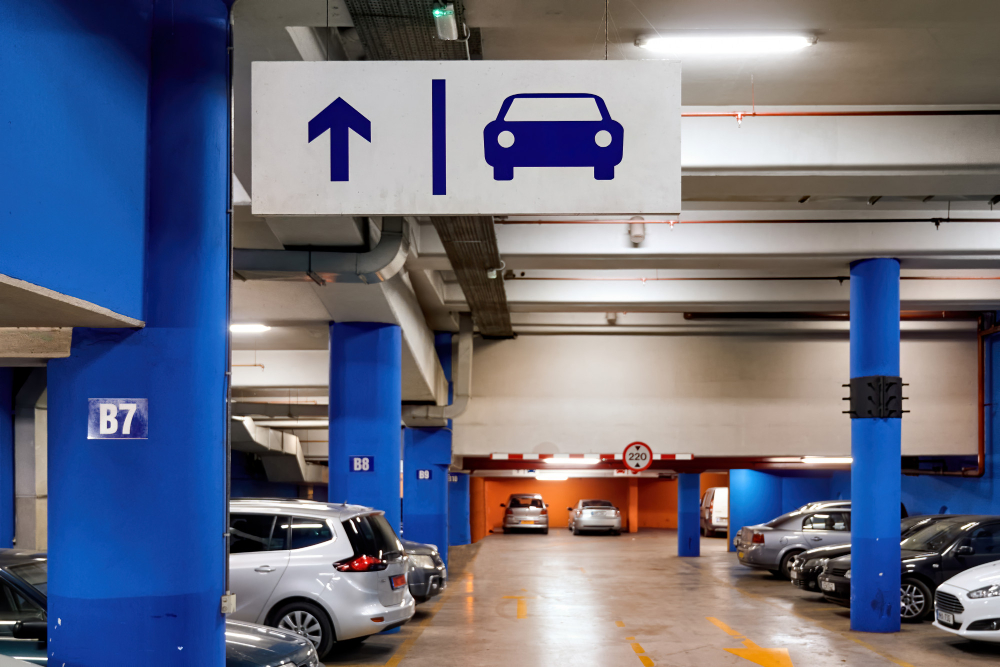Have you ever found yourself circling a car park, confused about where to go or whether that spot’s actually available? What about those near-miss moments when a car suddenly appears from a blind corner? Or perhaps you’ve wondered why some car parks feel safer than others, even when they’re equally busy?
The truth is, those seemingly mundane signs scattered throughout car parks play a far more crucial role in urban safety than most of us realise. From preventing accidents to managing traffic flow and protecting pedestrians, car park signage forms an invisible safety net that keeps thousands of Brisbane drivers and pedestrians safe every single day. In bustling urban areas where space is at a premium and vehicles constantly jostle for position, proper signage isn’t just about convenience it’s about creating order from potential chaos.
Throughout this article, we’ll explore the fascinating world of car park safety signage, examining everything from the psychology behind effective wayfinding to the latest smart technologies revolutionising how we navigate these concrete mazes. You’ll discover the different types of signs and their specific safety functions, learn about legal requirements that property owners must follow, and understand why proper placement can make or break a sign’s effectiveness. We’ll also look at common mistakes that compromise safety and peek into the future of parking technology that’s already arriving in Brisbane’s most forward-thinking facilities.
The Critical Connection Between Car Park Signage and Urban Safety
How Poor Signage Creates Safety Hazards
When car park signs are missing, damaged, or poorly designed, the consequences extend far beyond minor inconvenience. Inadequate signage transforms car parks into accident hotspots where confusion reigns and safety takes a back seat. Without clear directional markers, drivers create their own paths, often cutting across pedestrian zones or driving against the intended traffic flow. This chaotic environment increases stress levels, leading to aggressive driving behaviours and snap decisions that put everyone at risk.
The ripple effects of poor signage multiply quickly in busy urban environments. A single missing “No Entry” sign can cause head-on collisions in narrow lanes, whilst faded pedestrian crossing markings leave vulnerable foot traffic exposed to moving vehicles. Speed limit signs that have fallen or become obscured by overgrown vegetation mean drivers default to their own judgement, often misjudging appropriate speeds for tight corners and blind spots.
What’s particularly concerning is how poor signage disproportionately affects certain groups. Elderly drivers, those unfamiliar with the area, and people with disabilities rely heavily on clear visual cues to navigate safely. When these cues are absent or confusing, these vulnerable road users face increased risks, turning what should be a simple parking experience into a genuinely dangerous situation.
The Psychology Behind Effective Car Park Navigation
Our brains process visual information incredibly quickly, making split-second decisions based on colours, shapes, and symbols we encounter. Effective car park signage taps into this psychological processing, using universally understood visual languages that transcend spoken language barriers. Red means stop or danger, green indicates go or safe passage, and yellow warns us to proceed with caution these colour associations are deeply ingrained in our collective consciousness.
Well-designed car park signs work because they reduce cognitive load during an already stressful activity. Think about it: you’re controlling a large vehicle in tight spaces, watching for pedestrians, checking mirrors, and trying to find a suitable spot—all whilst potentially running late for an appointment. Clear, consistent signage removes the guesswork from this equation, allowing drivers to focus on the essential task of safe vehicle operation rather than decoding confusing or contradictory messages.
The placement and repetition of signs also plays into our psychological need for reassurance. Strategic positioning of directional signs at decision points confirms we’re on the right path, reducing anxiety and preventing the panicked last-minute lane changes that cause accidents. This psychological comfort translates directly into safer driving behaviours, as confident drivers make more predictable movements that other road users can anticipate and respond to appropriately.
What Are the Different Types of Car Park Signs and Their Safety Functions?
Regulatory Signs: Setting the Rules
Regulatory signs form the backbone of car park safety, establishing the fundamental rules that keep traffic flowing smoothly and safely. These include stop signs at internal intersections, give way markers at merge points, and those all-important speed limit indicators that remind drivers they’re not on the open road. In Brisbane’s busy shopping centres and office complexes, these signs create a framework of expected behaviours that everyone can follow.
Beyond basic traffic control, regulatory signs also designate special-use areas that require extra care. Disabled parking bays, parent-with-pram spaces, and loading zones all fall under this category, each serving specific safety functions. These designated areas aren’t just about convenience they’re strategically located to minimise the distance vulnerable users need to travel through active traffic areas, significantly reducing their exposure to potential accidents.
One-way system signs deserve special mention here, as they’re perhaps the most critical regulatory elements in modern car parks. By eliminating the possibility of head-on collisions in narrow lanes, these signs transform potentially dangerous two-way squeezes into manageable single-file passages. The safety benefits multiply in multi-storey facilities where spiral ramps and limited visibility would otherwise create perfect conditions for serious accidents.
Warning and Hazard Signs: Preventing Accidents
Warning signs act as the car park’s early alert system, flagging potential dangers before drivers encounter them. These bright yellow or orange markers grab attention with their distinctive diamond shapes and bold graphics, alerting drivers to height restrictions, sharp turns, steep ramps, and pedestrian crossing points. Their high-visibility design ensures they’re noticed even in poor lighting conditions or when drivers are distracted.
The strategic placement of hazard warnings can prevent countless accidents. Signs indicating “Blind Corner Ahead” or “Hidden Driveway” give drivers crucial seconds to adjust their speed and heighten their awareness. Similarly, “Slippery When Wet” warnings near entrances and exits remind drivers that weather conditions affect braking distances, particularly on the smooth concrete surfaces typical of covered car parks.
Modern car parks increasingly feature dynamic hazard warnings that respond to changing conditions. Electronic signs that activate during peak periods to warn of heavy pedestrian traffic, or sensors that trigger warnings when large vehicles are manoeuvring in tight spaces, represent the evolution of traditional static signage into responsive safety systems that adapt to real-time risks.
Directional and Wayfinding Signs: Reducing Confusion
Directional signage might seem like it’s purely about convenience, but its safety implications run deep. Clear wayfinding reduces the dangerous behaviours that emerge when drivers become lost or frustrated sudden stops, unexpected reversing, and erratic lane changes all decrease when drivers know exactly where they’re going. A well-signed car park creates predictable traffic patterns that everyone can anticipate and navigate safely.
The best directional systems use a combination of overhead signs, wall-mounted markers, and ground-level indicators to guide drivers smoothly from entry to exit. Colour-coding different levels or zones adds another layer of clarity, particularly useful in large facilities where drivers might otherwise struggle to remember where they’ve parked. This systematic approach prevents the dangerous scenario of confused drivers stopping suddenly in traffic lanes to get their bearings.
Exit signage deserves particular attention in the safety conversation. During emergencies, clear exit marking can literally save lives, guiding panicked drivers and pedestrians to safety without creating bottlenecks or confusion. The requirement for illuminated exit signs isn’t just bureaucratic red tape it’s a crucial safety feature that ensures evacuation routes remain visible even during power failures or smoke-filled emergencies.
Informational Signs: Enhancing User Experience
Informational signs might appear less critical to safety than their regulatory or warning counterparts, but they play a subtle yet important role in creating safer car park environments. Signs displaying parking rates, payment locations, and facility hours prevent the confusion and frustration that lead to distracted driving. When drivers understand the system, they’re less likely to make sudden decisions that endanger others.
Height clearance indicators at car park entrances prevent potentially catastrophic collisions between tall vehicles and overhead structures. These signs must be accurate and prominently displayed, as misjudging clearance can result in significant structural damage and serious injuries. Smart facilities now use sensor systems that provide vehicle-specific warnings, adding an extra layer of protection for drivers of vans, trucks, and vehicles with roof-mounted equipment.
Contact information and emergency procedure signs also fall into this category, providing crucial information when things go wrong. Whether it’s reporting a security concern, calling for medical assistance, or alerting management to hazards like oil spills, these signs ensure help is always just a phone call away. The peace of mind they provide contributes to a calmer, safer environment for all users.
How Do Car Park Signs Prevent Accidents in Brisbane’s Busy Urban Areas?
Speed Control and Traffic Calming Measures
Brisbane’s urban car parks face unique challenges with high vehicle turnover and constant pedestrian activity, making speed control absolutely vital for safety. Speed limit signs work hand-in-hand with physical calming measures like speed humps and raised pedestrian crossings, but it’s the signs that provide the crucial context drivers need to understand why they should slow down. A well-placed “5 km/h – Children Present” sign carries more weight than an unmarked speed hump ever could.
The positioning of speed control signage follows careful consideration of sight lines and reaction times. Signs placed at car park entrances set expectations immediately, whilst reminder signs at regular intervals reinforce the message throughout the facility. This repetition isn’t redundant it’s a deliberate strategy that keeps speed awareness front of mind, particularly important when drivers might be distracted by searching for parking spaces.
Electronic speed displays that show drivers their actual speed have proven particularly effective in Brisbane’s busier facilities. These interactive signs tap into our natural competitiveness and desire for compliance, with most drivers automatically adjusting their speed when confronted with real-time feedback. The psychological impact of seeing “YOUR SPEED: 15 km/h” in bright red LEDs is far more powerful than passive signage alone.
Pedestrian Safety Zones and Crossings
Pedestrian safety represents perhaps the greatest challenge in car park design, with foot traffic and vehicles sharing the same space in ways they rarely do on public roads. Clear signage establishing pedestrian priority zones, marked crossings, and safe walking routes creates a visual contract between drivers and walkers that dramatically reduces accident rates. These signs don’t just mark territory they fundamentally alter driver behaviour and pedestrian confidence.
Zebra crossings backed by prominent signage transform dangerous conflict points into managed interaction zones. The signs alert approaching drivers well in advance, giving them time to scan for pedestrians and adjust their speed accordingly. Meanwhile, pedestrians gain confidence knowing they have designated safe crossing points, reducing the likelihood of them darting between parked cars or taking dangerous shortcuts through active traffic lanes.
Family-friendly facilities in Brisbane increasingly feature dedicated pedestrian walkways with clear signage separating foot traffic from vehicles entirely. These signed pathways, often painted in bright colours and marked with walking figure symbols, create safe corridors that connect car parking areas to building entrances. The visual distinction these signs provide is particularly important for children, who might otherwise struggle to understand where they should and shouldn’t walk.
Visibility Solutions for Blind Spots and Dark Areas
Poor visibility remains one of the biggest safety challenges in car parks, particularly in older facilities or underground structures. Convex mirror signs at blind corners provide drivers with crucial visibility around obstacles, whilst “Sound Horn” signs at these same locations add an auditory warning layer. These simple additions prevent countless collisions between vehicles emerging from hidden positions.
Illuminated signage plays a dual role in dark areas, both conveying important information and contributing to overall visibility levels. Backlit signs at regular intervals create pools of light that help drivers gauge distances and identify potential hazards. In Brisbane’s subtropical climate, where sudden afternoon storms can plunge car parks into premature darkness, these illuminated markers become essential navigation aids.
The rise of photoluminescent signage offers an innovative solution for emergency situations. These signs absorb light during normal conditions and glow in darkness, providing crucial wayfinding even during complete power failures. Particularly important for emergency exits and evacuation routes, this technology ensures safety signage remains functional when it’s needed most.
Conclusion
Looking back through everything we’ve explored, it’s clear that car park signs are far more than just functional necessities they’re vital components of urban safety infrastructure that protect thousands of Brisbane residents and visitors every day. From the psychology of effective wayfinding to cutting-edge AI systems, proper signage transforms potentially chaotic spaces into orderly environments where vehicles and pedestrians can coexist safely.
The journey towards safer car parks doesn’t require revolutionary changes overnight. Simple improvements like replacing faded signs, adding reflective materials to existing markers, or conducting regular safety audits can deliver immediate benefits. Property owners who invest in quality signage aren’t just meeting legal obligations they’re actively contributing to the safety and wellbeing of their communities whilst protecting themselves from liability risks.
Company Name: Group One Line Marking
Address: Unit 17/205 Port Hacking Rd, Miranda NSW 2228
Mobile No.: 0414153837
For More Information, Visit Our Website











Leave a Review